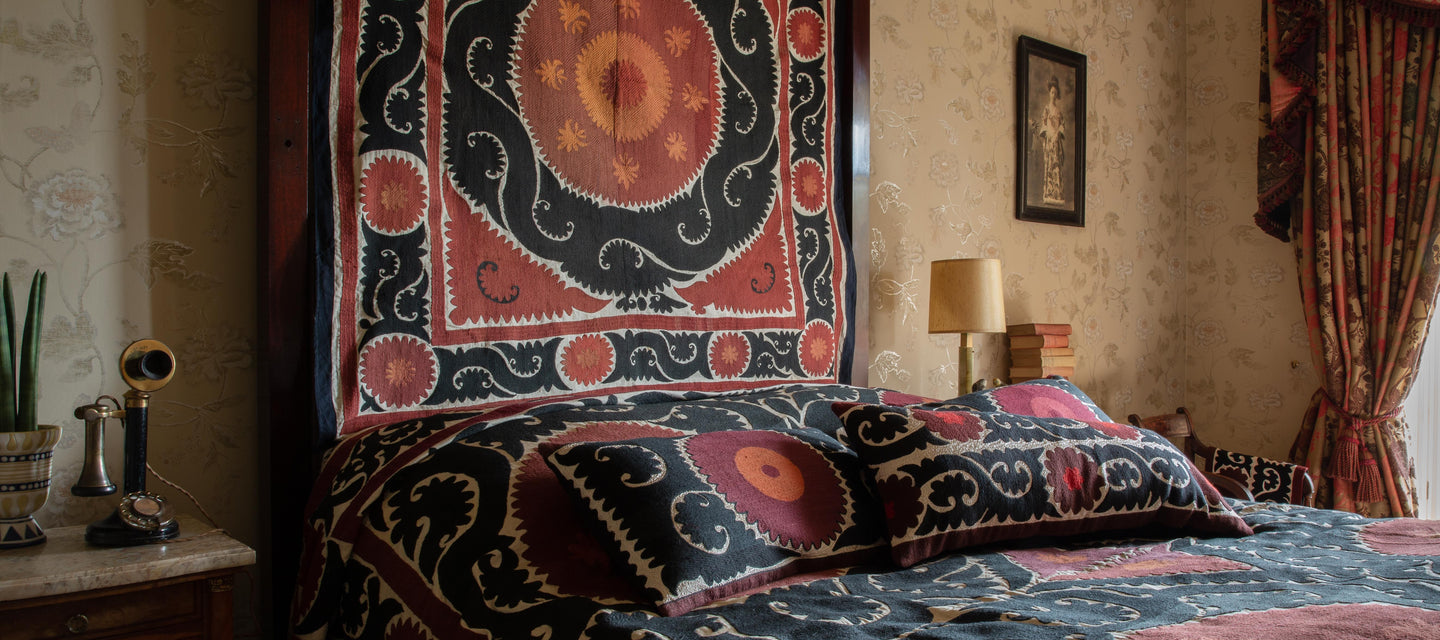Suzanis hold a special place in traditional Central Asian culture. They are decorative, large-scale, handmade wall panels, and are one of the most popular kinds of Uzbek and Tajik embroidery. Suzani embroidery is a unique phenomenon derived from the late medieval culture of Central Asia’s cities and villages. Today, the ancient archetypes and medieval symbols in the patterns are still in use and reflect the interaction of various historical and artistic traditions of the Silk Road.
The term “Suzani” derives from the Farsi word for needle and needlework "suzanikari". These pieces were usually embroidered with silk thread on narrow lengths of handwoven undyed cotton cloth (karbos). Beginning in the 1880s, silk was used as a ground cloth in addition to cotton, but it was more expensive and generally didn’t hold up as well. For large Suzanis, a master draftsman (kalamkash), drew a traditional pattern onto loosely joined fabric panels. The panels were then separated so that two or more family members or friends could work on the embroidery simultaneously. Later when the panels were re-joined, the pattern parts might not match perfectly, and extra stitches were added along the seams.
Suzanis were traditionally created as beautiful, handcrafted dowry pieces that the women in a family laboriously created together for a bride’s wedding day. Weddings were major events in Central Asian tribal society. They represented the binding together of two people and the fusion of two families. Not surprisingly, therefore, their patterns and motifs represent luck, health, long life and, above all, fertility. The Suzani itself was used as the coverlet for the bridal bed on the wedding night, and later as decoration on the walls.
The main centres of Suzani embroidery are in the regions of Samarkand, Urgut, Surkhandariya, Kashkadariya, and Bukhara, as well as in Shakhrisabz, Andijan and Tashkent. The patterns and motifs differ distinctly from region to region and have their roots in early religious and nomadic traditions.
Tashkent and Samarkand Suzanis are dominated by astral and solar symbols. In Tashkent, Suzanis are known as palak (heavens), oy-palak (moon heavens) or yulduz-palak (start heavens). The images of heavenly stars are an ancient tradition whose roots date back to the early origins of culture. Artisans of the time considered these patterns to provide heavenly protection. Over time, as religions and cultures shifted, astral symbols transformed into vegetative and floral symbols, reflecting the change of religious representations in society and a depreciation of old beliefs.
Vegetative motives in Suzanis are often a reflection of everlasting nature. The content is connected with ancient beliefs around fertility, which can be seen especially in the Suzanis of the Ferghana Valley.
Some motifs, especially in rural embroideries, are derived from the heritage of ancient settled and nomadic cultures and were originally found in the carpets of these tribes. An example of these “carpet” motives includes kuchkorak and mujiz-nuska (ram’s horns), Zoroastrian motifs (the Iranian religion founded in circa 600b.c.), the sun and nature also feature. The meanings of former solar, Zoroastrian and totemic symbols have been forgotten. Instead, craftswomen have considered these patterns simply “useful” and protective and as result, many names of motives no longer reflect their original meaning.
Suzanis generally employ several types of stitches: couching (basma), chain stitches (yurma), and open chain stitches or ladder stitches (ilmok or ilmoq), with regional variations. Chain stitching was done with either a needle (nina) or a handheld tambour hook (bigiz, daravsh) creating a very fine stitch.
The chain stitch (bigiz) is the most distinctive feature in the Bukhara school of embroidery. A close look at a Suzani made by the craftswomen of Bukhara will reveal plenty of small details, which draw the whole composition together beautifully. Modern embroidery from Bukhara often includes sprouts with flowers all over the surface of the fabric and round rosettes in light colour combinations.
Embroiderers from Urgut use couching stitch (basma). Suzanis from Urgut are usually made on white cloth, although occasionally on yellow or crimson silk. The designs are often taken from ancient magical patterns as well everyday items that craftswomen use.
Shakhrisabz embroidery is distinguished by a special vividness. It is made using chain (yurma) stitches on a colourful background and the Suzanis of this region look more like carpets than embroidered textiles.
Embroidery from the Surkhandariya and Kashkadariya regions tend to use ancient, ornamental motifs with a kanda khayol stitch and a distinct, high-contrast colour spectrum.
The Lakai style of embroidery is quite different from most other Uzbek styles in that it utilizes a distinct style of cross-stitch, more common worldwide but unusual in Central Asia, and associated most closely the Lakai tribe. Clean, sharp lines and flat surfaces of clear, saturated colour are characteristic of true Lakai embroidery. The cross stitch is worked very densely, covering the entire ground fabric and often utilizing a warm colour scheme and large block imagery.
Often the meanings of the more ancient inherited symbols may have been lost and forgotten yet they are still used as decorative elements in contemporary Suzani design. In each case Suzanis imagery represents notions of an ideal universe, and the unity of magic and beauty.

